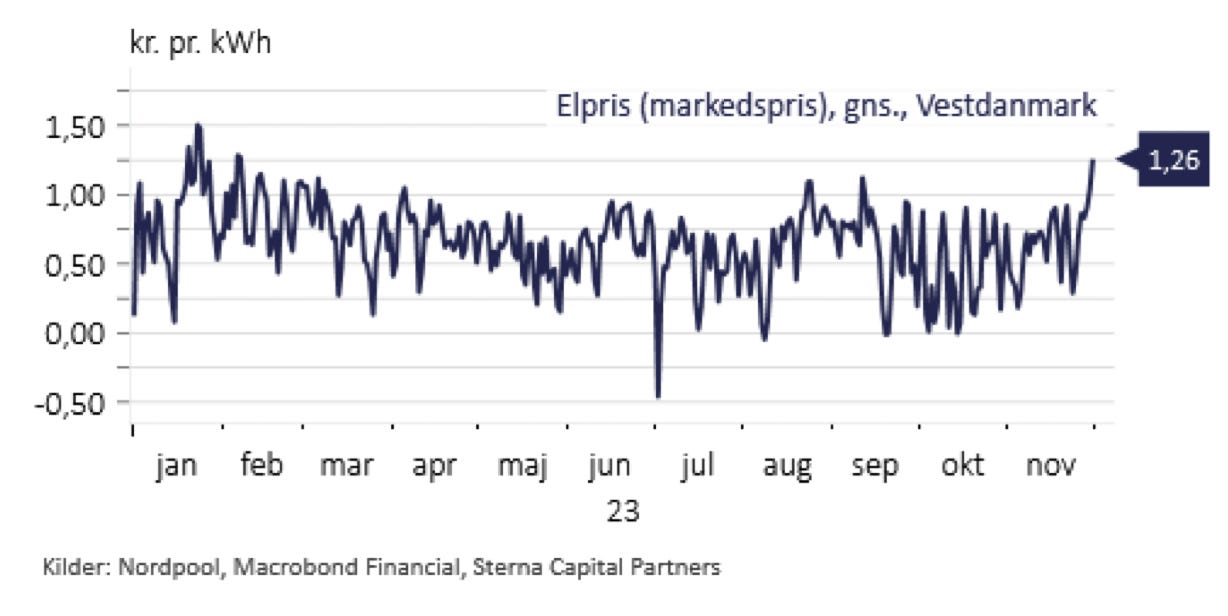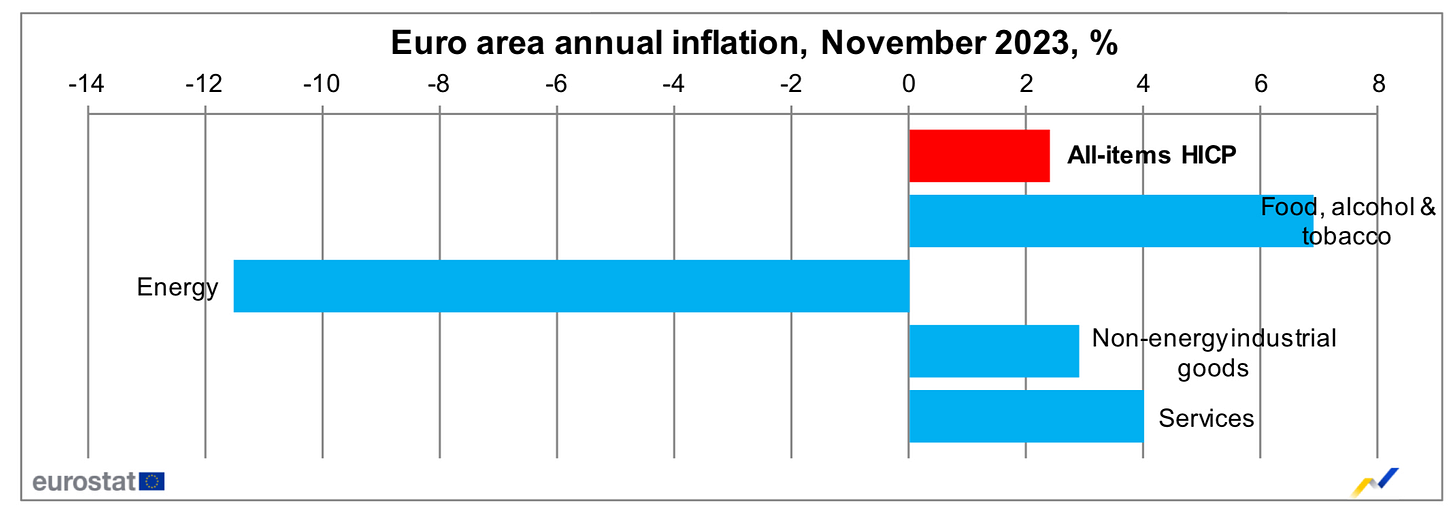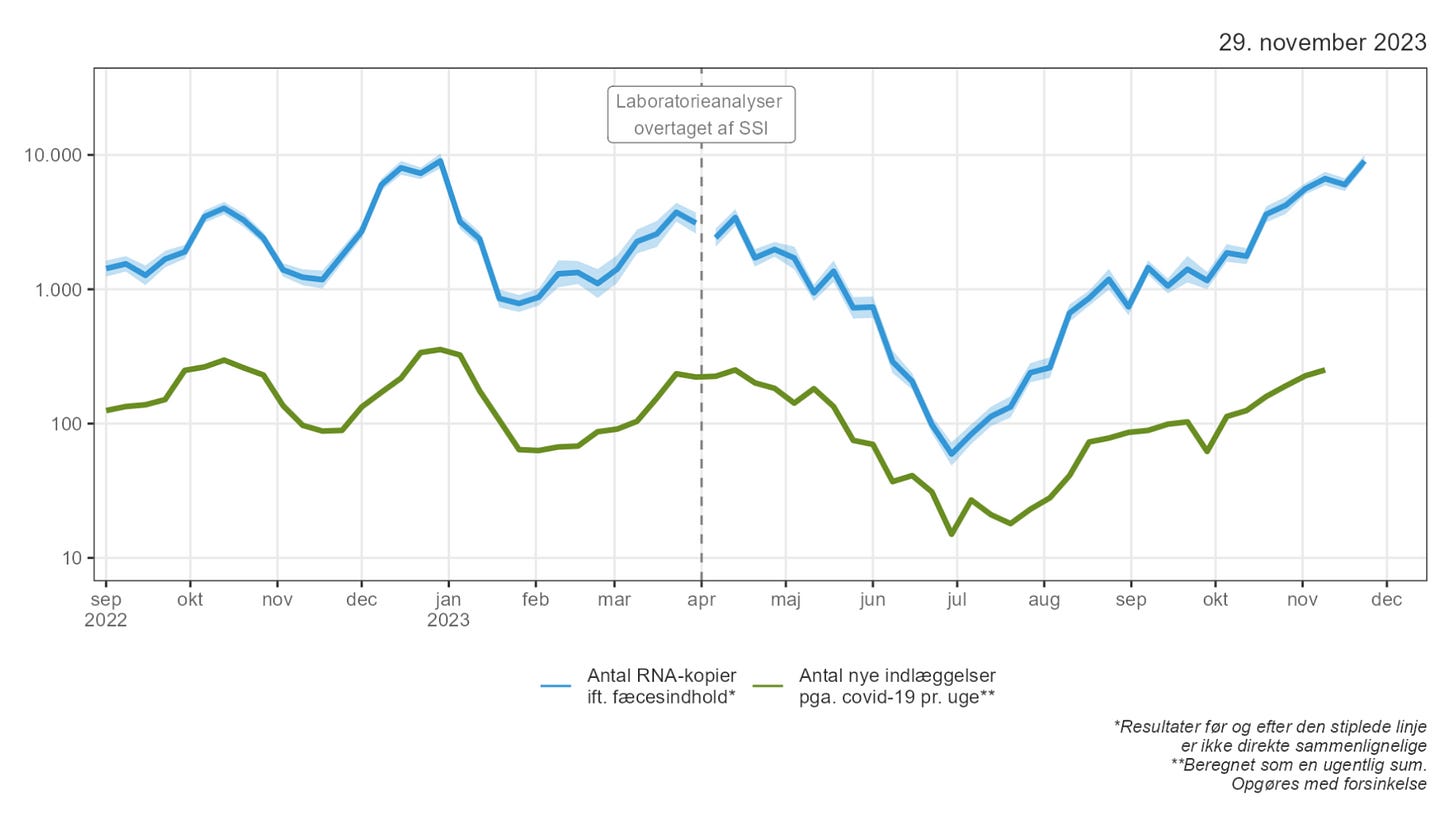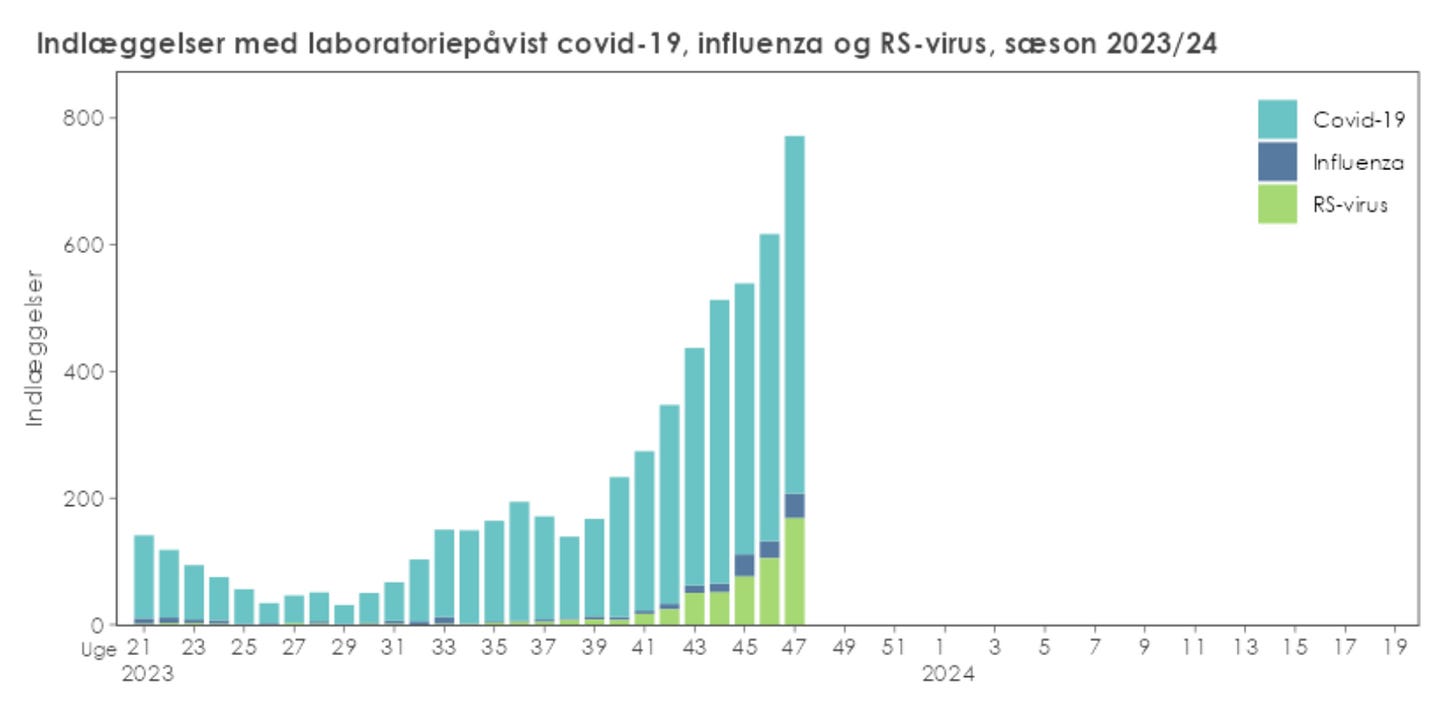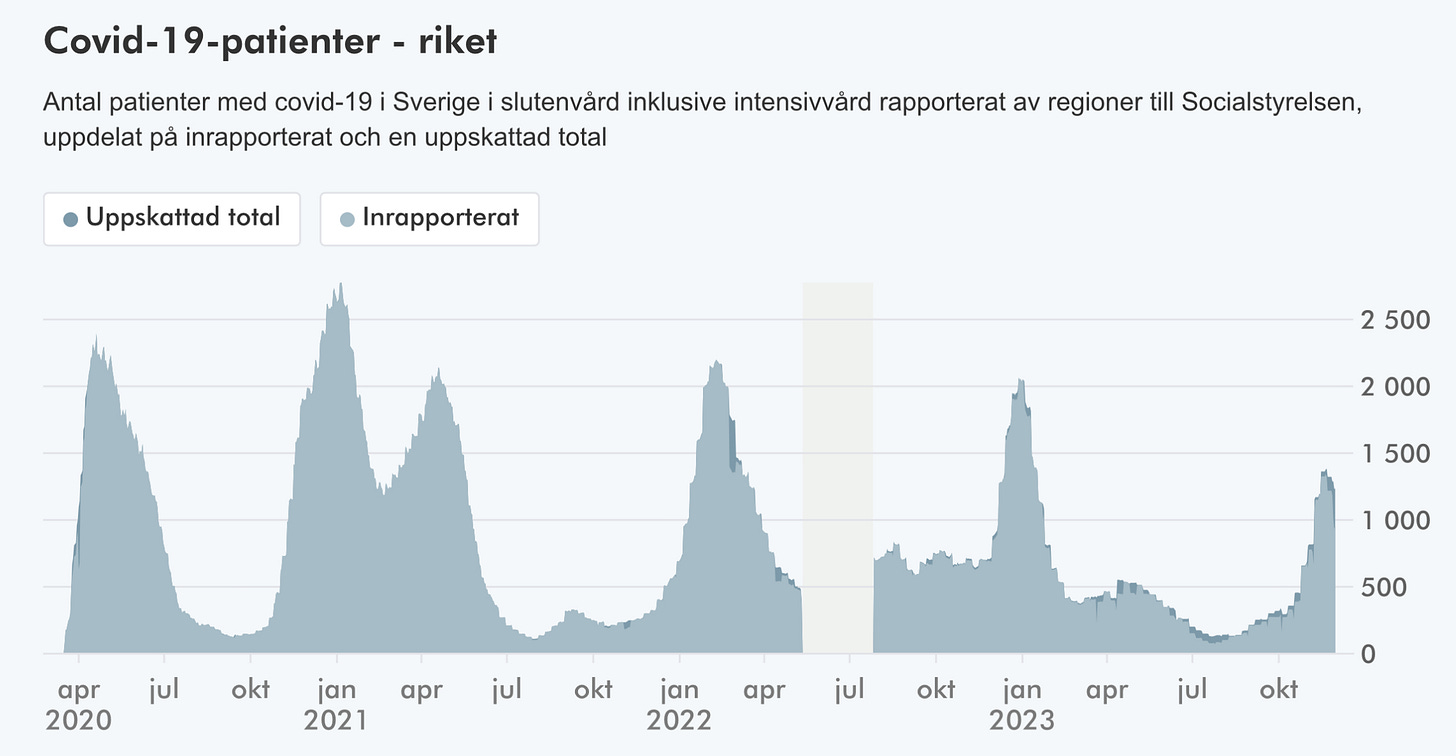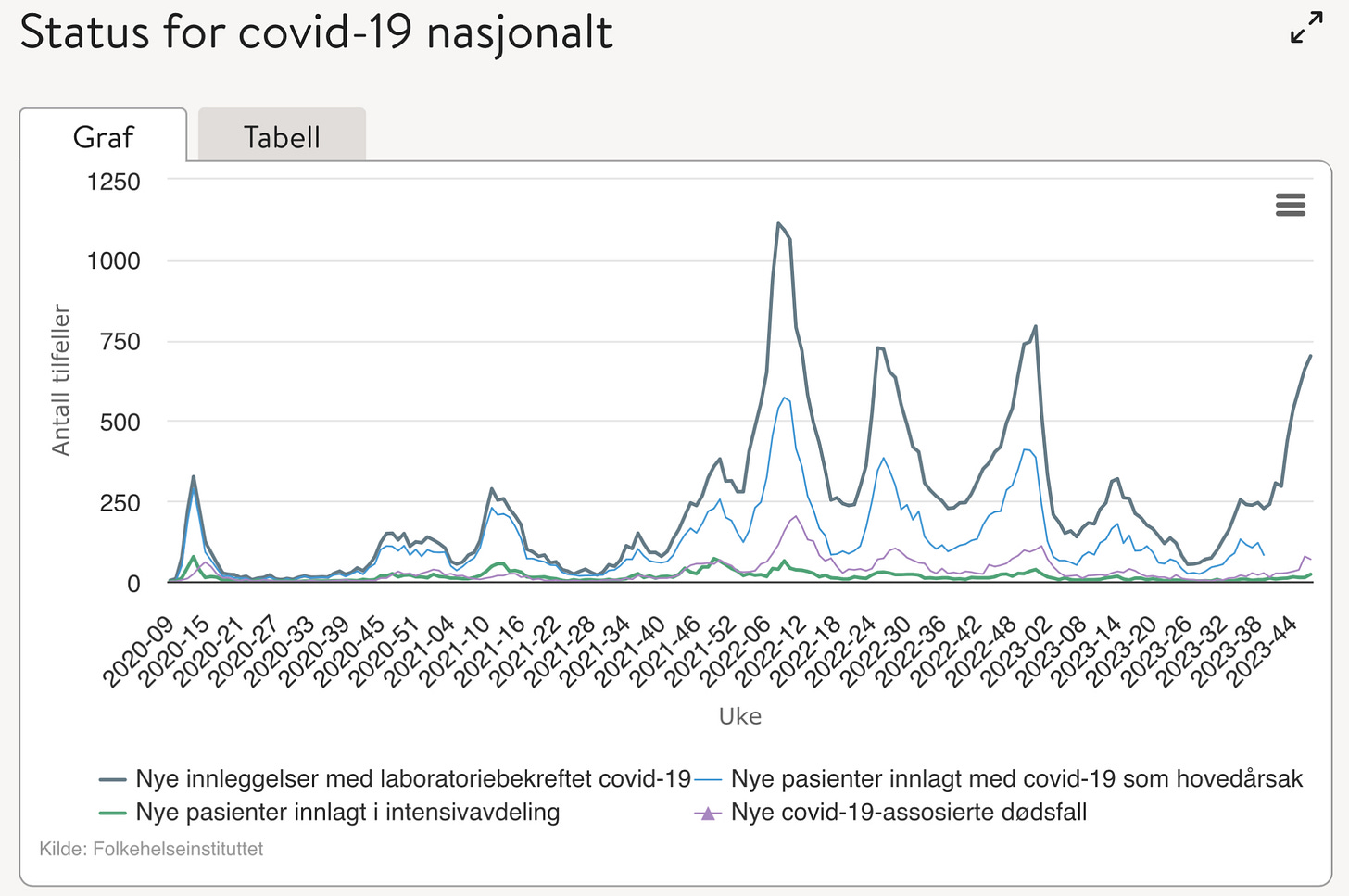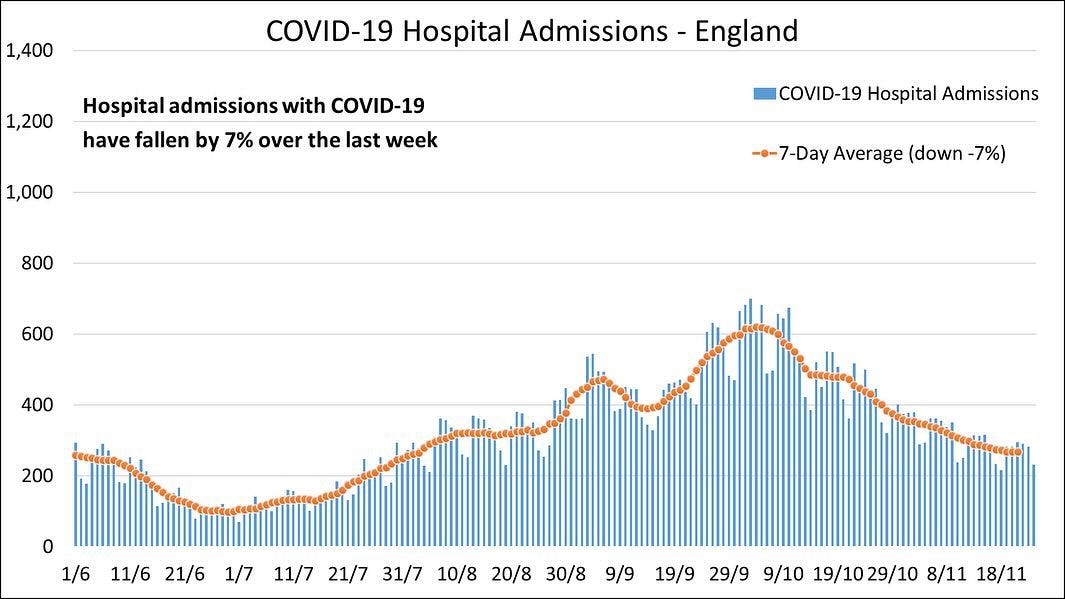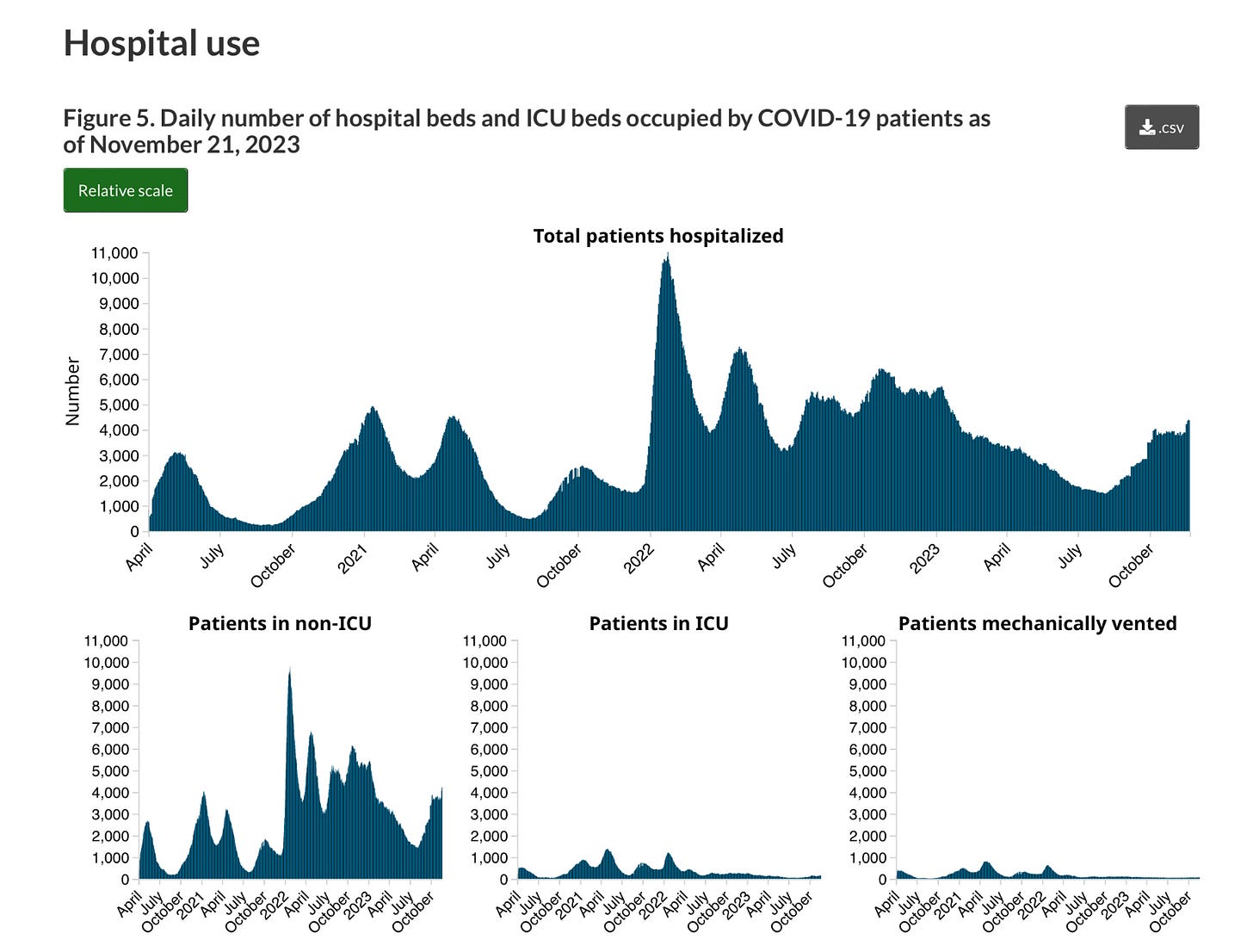Editor’s Note - Informeret is taking a break for Christmas a little earlier than I had planned due entirely to a burgeoning to do list and dwindling time to get it all done. Thanks for reading along this year and welcome to everyone who joined us in 2023. I wish you all a very Merry Christmas and a glorious New Year. See you soon.
🍃Environment & Energy⚡️
🌍 🍃
The COP28 Environmental conference began on Thursday in Dubai. Ahead of the conference, UN Secretary-General António Guterres told AFP that he wants an agreement to completely phase out fossil fuels when COP28 ends. And he added that the agreement must be strict and it must be binding, with no more cop-out language,
“I think it would be a shame if we continue with a vague and non-binding phasing out, the meaning of which is not clear to everyone.”
The COP28 conference ends on December 12.
-
UN Secretary-General António Guterres opened the COP28 climate summit Thursday by declaring that 2023 will be the hottest year in human history despite one month still left to go.
“This year, communities across the globe have been ravaged by fires, floods, and scorching heat. The record rate of global warming should send a chill down the spine of world leaders. And that should get them to act.”
The World Meteorological Organization confirmed the news with a report published after the announcement.
🌍 🍃 🇩🇰
Countries around the world have agreed to conditions for a new climate fund that will help poorer countries deal with climate change damages and losses. Host country Dubai immediately pledged $100 million for the new fund. Denmark will contribute 350 million Danish kroner (about $69 million Cdn) to countries affected by climate change damages, of that 175 million will go to this newly established fund.
Danish Prime Minister Mette Frederiksen went to COP28 with her top priority being to ensure wealthier countries help poorer nations battle climate change.
“We are some of those who have emitted the most. The immediate consequences of climate change are most felt in the countries where the population emits the least.”
🇩🇰
The Danish government tabled its latest budget this week and it includes an injection of cash to help municipalities with clean-up and repairs after last month’s major flood. The budget contains a storm surge pool of 125 million Danish kroner (about $24.7 million Cdn). Municipalities can apply to the fund to cover up to 25% of their costs for flood recovery, which still won’t cover the full flood repair bill for many of the harder-hit areas.
-
After a hot summer setting new daily and monthly heat records across Denmark the overnight temperatures from Tuesday to Wednesday this week in places were the coldest in decades. Roskilde airport recorded -15 degrees overnight, the lowest temperature on a November night in 30 years. In Copenhagen, temperatures fell to -7.7 degrees, the coldest November night in more than 100 years. You would have to go all the way back to 1919 to find anything as cold.
The Danish Meteorological Institute says temperatures have only been that cold 13 times since the agency began keeping records in 1873. The coldest November on record was in 1973 when it dropped to -21.3 degrees.
-
As winter temperatures arrive people are cranking up their thermostats and electricity prices are heading upward once again. We are now in the ‘danger zone’ where Old Man Winter holds all the cards. If all or parts of Europe go into a long deep freeze then it could trigger another energy crisis. If there is some kind of repeat of last winter where Europe experienced a record-breaking heatwave then energy concerns will remain on the shelf.
The winter weather drove electricity consumption across Denmark to heights not seen since before the war in Ukraine began. According to Green Power Denmark on Wednesday, a total of 127.9 gigawatts of electricity was used across the country as people turned up the heat. That is the highest single-day usage of electricity in almost two years.
🇪🇸
A tale of two Europes. While the spring brought rain by the bucket load across the Nordics and then Old Man Winter arrived a far different story is unfolding in Spain. Catalonia is suffering its worst drought on record as an unrelenting streak of hot dry weather continues. Water reservoirs in Catalonia are now at just 18% of capacity. Nationally, reservoirs as a whole are at 43%. Six million people in the region, which includes Spain’s second largest city Barcelona rely on the reservoirs for their water. Barring a massive downpour of rain arriving in the next couple of weeks, Catalonia may have to have fresh water shipped in by boat.
If water reservoirs in Catalonia fall below 16% then it would automatically trigger a drought emergency and severe water restrictions.
In the meantime, some water restrictions have already been introduced. People are limited to a maximum of 230 liters of water per day. The Catalonia’s water agency estimates that on average 116 liters are consumed each day per person for domestic use. Use of water for street cleaning or watering lawns is now banned. Water use has also been limited for the industrial and agricultural sectors.
🇩🇰
The energy transition has hit a hiccup in eastern Jutland. Denmark is pushing hard to get homes onto district heating or getting them moved from gas boilers to heat pumps. In the eastern Jutland towns of Herskind and Låsby it looks like an effort to introduce district heating (fjernevarme in Danish) will come to a crashing halt. In order to get the towns hooked up at least 70% of homeowners must sign on by midnight Thursday. As of Wednesday night, less than 25% of homeowners in either town have signed up. Cost appears to be the big roadblock.
🇫🇮 🇸🇪
Not one but two nuclear reactors in the Nordics had to shut down this week causing electricity spot prices to fluctuate wildly. In Finland, the Olkiluoto 3 nuclear reactor shut down on Wednesday when a fault was discovered. It turned out to be a short circuit and the plant was back online by Thursday evening. It is the second time this month that the nuclear reactor has had to shut down.
Just hours earlier the Ringhals plant in Sweden also had to shut down taking more electricity out of the Nordic energy market.
🇫🇮
The Finnish Energy Authority says the electricity supply over the winter will be sufficient to meet the country’s needs even during the highest peaks of usage. However, it also cautions that if something unforeseen should happen like multiple disruptions impacting power production or transmission it could pose a serious problem.
The authority also examined Finland’s natural gas situation with the Balticconnector pipeline remaining offline until next spring. It concludes that there is a sufficient supply of LNG for the cold winter months ahead thanks to the Inkoo LNG terminal in southern Finland. But it again cautioned that if something unforeseen impacts the LNG terminal then it be a real problem.
🇸🇪
Tesla has won a battle in its labour dispute against striking Swedish workers but the war is far from over. The labour dispute has received widespread support across deeply unionized Sweden with postal workers not delivering Tesla’s mail and dock workers refusing to unload Tesla shipments. But the courts have struck down one of the support efforts where the Swedish Transport Agency was refusing to issue license plates for new Tesla vehicles. The court said license plates must be issued and if compliance doesn’t happen within seven days the transportation agency will be hit with a one million Swedish kroner fine (about $129,000 Cdn).
🇪🇺
Inflation is expected to have eased across the Euro area in November according to preliminary estimates from the EU statistics agency EuroStat. It is pegging inflation in November to be 2.4% down from October’s 2.9%.
🇩🇰
Pharmaceutical giants have been giving the Danish economy a big shot in the arm but even their influence has limits. In October, the pharmaceutical industry, driven by Novo Nordisk and Lundbeck, was responsible for the entire growth of Denmark’s GDP.
In its latest assessment from the international economics organization, OECD, it forecast that Denmark would see anemic economic growth next year of just 1.2%. It blames higher financing costs, rising wages, and an expected decline from the pharmaceutical sector for its assessment.
🦠COVID🦠
🇩🇰
After a lull last week, coronavirus activity across Denmark has increased again according to wastewater surveillance testing. COVID activity (blue line) rose again last week and that has pushed up the average growth over the last three weeks.
Along with the increase in coronavirus activity, infection-related hospitalizations (green line) also continue to climb.
Along with increasing numbers of COVID hospitalizations the number of RS virus-related admissions also continues to rise.
Denmark’s Statens Serum Institute has declared a mycoplasma pneumoniae epidemic.
Senior Researcher Hanne-Dorthe Emborg:
“In the past five weeks, the number of new cases has increased significantly, and we are now seeing significantly more cases than usual, and there is widespread infection spread throughout the country.”
Last week there were 541 cases of pneumonia, which is a major jump from the 168 infections of just five weeks ago. The SSI cautions these numbers are likely underreported due to a lack of testing.
This type of pneumonia can cause flu-like symptoms like fatigue, headaches, sore throat, and a prolonged dry cough. It also often causes a mild fever.
Emborg says that Denmark historically sees a mycoplasma pneumoniae epidemic about every four years.
"Mycoplasma infections come in waves, where the disease affects groups in the population that have not yet built up immunity. Therefore, it is also typically a disease seen among school-aged children aged 6 to 12.”
Like many of the usual viruses that float around this pneumonia strain all but vanished during the first two years of the COVID pandemic.
“Precisely because the number has been so low in the past 3 and a half years, and there is therefore a group of children who have not yet built up immunity, we can probably also expect a higher incidence rate this season than what has been seen during previous MP- epidemics before the pandemic.”
The SSI notes that the pneumonia has not historically caused that many hospitalizations so it shouldn’t have much of an impact on the healthcare system. Denmark currently has the highest number of MP infections among countries seeing infection activity. Sweden and Singapore have the 2nd and 3rd highest infection numbers.
Denmark has also been battling a months-long whooping cough epidemic.
-
With lackluster testing and no COVID restrictions to speak of, the Danish National Health Authority is falling back on awareness campaigns to remind people to do their bit to prevent infection spread.
At the moment Denmark is in a COVID wave, while RS virus cases are rising, all the while battling whooping cough and pneumonia epidemics. Not to mention an imminent influenza season.
Section Leader Karen Geismar:
"It is entirely to be expected for the time of year that infection numbers increase. But we think it is important to remind everyone that we ourselves can help prevent infection by remembering to wash our hands, stay home if we are sick, cough and sneeze into our sleeves, and ventilate and clean indoor spaces and surfaces.”
To hammer that message home the health authority is releasing a video called “Real Heroes”, which is below.
🇸🇪
The Swedish Public Health Agency says the overall COVID situation is more or less unchanged week to week. It says while there is still a significant infection spread the agency sees some indication the current wave may be receding.
The positivity percentage remains at a high 34%, the same as it was last week.
Confirmed infections among seniors in care (523) were down 12% week to week while cases among seniors receiving home care (835) also dropped slightly (-5%).
The health agency says intensive care numbers are somewhat understated due to some reporting delays.
The number of COVID deaths across Sweden is increasing. 174 people lost their lives to the virus last week and another 190 the week before. This compares to an average of 81 virus-related deaths in weeks 42 through 44.
BA.2 sub-variants are dominant in Sweden. JN.2, HK.3, and HV.1 made up the bulk of all confirmed new infections. JN.2, a sub-strain of the BA.2.86 variant, seems to have the highest growth rate going from 12% to 20% of all sequenced positive test results in the last month.
-
In Sweden, COVID hospitalizations (956) continue to ease (-263) while intensive care admissions (31) creep upward (+3).
-
The Swedish Public Health Agency says the annual influenza wave has arrived. It says the number of flu cases is expected to increase in the weeks ahead. The agency is urging seniors, pregnant women, and other high-risk groups to get a flu shot as soon as possible.
Last week the number of influenza infections rose sharply with 64% more cases than the week before.
Sweden has been offering influenza and COVID vaccinations since October when it began inoculating seniors in care with other eligible groups starting in November. So far, 45% of seniors have a COVID booster dose. The agency says influenza vaccination statistics are not yet available.
State Epidemiologist Magnus Gisslén:
“The best way to protect yourself from severe infection is through vaccination, so it is positive that many have already chosen to accept the vaccination offer. We want to urge all people who are eligible to get vaccinated as soon as possible against both influenza and COVID in order to be protected during the time when the virus circulates the most.”
In Sweden, seniors over 65, pregnant women, and people in high-risk groups are eligible to get a COVID booster dose and a flu shot.
🇫🇮
The Finnish Institute for Health is warning that the number of COVID deaths across the country will likely increase in the coming weeks even though it says the latest coronavirus wave “has clearly subsided.”
Leading Expert Sirkka Goebeler:
“Based on the statistics over the last few weeks it appears the number of COVID deaths is increasing at the same rate as this time last year. Coronavirus has driven the autumn respiratory infection wave and thus also deaths.”
As seen elsewhere, the institute says it is elderly seniors who are in harm’s way suffering the bulk of severe infections, hospitalizations, and fatalities. It says the median age for COVID-related fatalities is 84 for men and 87 for women.
Chief Physician Tuija Leino warns that the number of coronavirus fatalities is likely underreported.
"COVID has caused the deaths of our very weakest patients so far this autumn. If there is no accurate diagnosis of which infection the elderly person has at the time of death, the death will not be registered as a coronavirus death, even if COVID could have caused it. In the same way, the annual numbers of deaths caused by, for example, influenza or RSV are also underestimates.”
As far as actual numbers.
"The causes of death are verified from death certificates. About 1,200 deaths caused by coronavirus have been recorded on death certificates so far in 2023. In addition to these, COVID infection has been recorded as having contributed to around 1,000 deaths. In 2022, about 3,800 deaths caused by corona were recorded, and about 2,400 cases where coronavirus contributed to death. More and more often, in connection with coronavirus infection, the cause of death is something other than corona, most commonly dementia or heart disease.”
Finland has reported 11,105 total to-date pandemic deaths since COVID arrived in the spring of 2020.
🇳🇴
Health officials in Norway are growing increasingly concerned about being overwhelmed by an onslaught of respiratory infection activity this winter. The Norwegian Institute of Public Health has done a risk assessment and concluded that on top of the ongoing COVID wave, an arriving influenza wave, and an imminent RS virus wave, Norway could also get hit with whooping cough and pneumonia epidemics.
Last winter, Norway had near-simultaneous coronavirus, influenza, and RS virus infection waves that dramatically increased pressure on its healthcare system.
Infection Control Director Trygve Ottersen:
“The burden on the health system has begun and may be prolonged if waves and epidemics follow one another. Simultaneous waves or epidemics can cause a heavy burden, especially between mid-December and mid-January.”
Ottersen cautions that wave after infection wave will mean a major increase in staff being out sick especially healthcare workers and that could have a serious impact.
The NIPH is warning hospitals, first responders, senior care home staff, and even family doctors, to prepare for the worst case scenario with multiple infection waves resulting in a major increase in workload and “more admissions than the usual pre-pandemic winters.”
It is also asking people to do their bit and stay home when they are sick, wash their hands regularly, and cough into their elbow.
-
Norway remains in the throes of a COVID infection wave with infection numbers continuing to increase over the last several weeks. However, the Norwegian Institute of Public Health says virus growth seems to have slowed somewhat in the last week. The agency cautions that new coronavirus variants are making the situation uncertain. Regardless, it is anticipating a holiday surge in infection activity and is advising hospitals to prepare for a wave of patients over the Christmas season. It is also urging all seniors and those in high-risk groups who have yet to get vaccinated to go get a COVID booster dose and a flu shot as soon as possible.
In its latest update, the NIPH says COVID hospitalizations continue to increase with 701 more admissions last week. Intensive care numbers also rose slightly with 22 new ICU patients.
COVID deaths have been increasing in Norway for three consecutive weeks. There were 69 more lives lost to the virus last week. The institute continues to emphasize that seniors over 75 and those who are unvaccinated make up the largest proportion of severe infections resulting in hospitalization or death.
On the variant front, the share of BA.2.86 variant infections has jumped from 5% to 40% of all sequenced positive test results since the beginning of October. The NIPH says the new strain will be dominant soon if it isn’t already and “this could potentially have an impact on the infection spread.”
Influenza numbers took a noticeable jump last week. The positivity percentage went from 3.4% to 4.7% in a week.
“This may mean that the outbreak is soon underway and that we may get an early peak around Christmas this winter as well.”
Flu-related hospital admissions also jumped from week to week with 83 last week compared to 57 the week before.
The NIPH says only a few RS virus infections have been detected. However, it is seeing rising numbers of mycoplasma pneumoniae cases. Neighbouring Denmark declared an epidemic of pneumonia bacteria this week.
Norway also continues to see the number of whooping cough cases head upward.
So far Norway’s vaccination effort has resulted in 60% of seniors in the target group getting an influenza vaccination while just 47% had a COVID booster. Just 30% of those in high-risk groups between 18 and 64 have had a flu shot.
🇬🇧
COVID hospitalizations continued to trend downward in England declining by 7% week to week according to the COVID Actuaries Response Group. Intensive care occupancy also declined by 7%.
The reinfection rate, or R0, has increased a little to 0.96. Anything over 1 indicates degrees of a spreading epidemic.
🇨🇦
The Public Health Agency of Canada says another 143 lives were lost to the coronavirus in the last week. The seven-day positivity percentage is 18.8%. Ontario and Quebec are seeing the most infection activity at the moment with both sitting at the second-highest virus activity level.
COVID hospitalizations continue to rise across Canada. In the week ending November 21, the total number of beds in use by an infected patient rose by 475 to 4,369 beds in use. Of those, general admissions continue to see the bulk of the admissions increase with 467 more patients from one week to the next pushing general admissions to 4,209. The number of infected people requiring intensive care crept up by 8 to 160. There were 78 severe cases requiring a ventilator, three more than the week before.
🇺🇦/ 🇷🇺 War
🇫🇮/ 🇷🇺
It has been one full day since Finland closed its entire land border with Russia over concerns about a rising tide of illegal immigrants. Finnish Border Guard Head of International Affairs Matti Pitkäniitty said as of Thursday it was so far, so good.
“First full day when all road border crossing points at Finnish-Russian land border are closed. The situation is stable for the moment, no new asylum seekers today.”
Almost 1,000 illegal immigrants have arrived from Russia at Finnish border crossings since August. Finnish officials have accused Russia of deliberately weaponizing immigrants to sow division among Western allies.
Finland will keep its entire eastern border closed until at least December 13.
🇪🇺/ 🇨🇳
European Union leaders have decided to nicely ask Chinese President Xi Jinping to reign in Chinese entities helping to circumvent sanctions against Russia over its invasion of Ukraine. The South China Morning Post is reporting that EU leaders are preparing to fly to China to take the matter up with Xi himself. The EU has so far avoided sanctioning Chinese companies that are helping to funnel sanctioned goods to Russia. The European Union estimates that Chinese companies are responsible for up to 70% of sanctioned high-tech products, many made in Europe, that are finding their way into the hands of Russian forces in Ukraine.
If China doesn’t comply the EU may name and shame the Chinese companies responsible or even sanction them.
🇬🇧 🇳🇱 🇮🇸 🇱🇻 🇱🇹 🇳🇴 🇸🇪 🇫🇮 🇩🇰 🇪🇪
Allied countries making up the Joint Expeditionary Force are increasing their naval presence and surveillance in the Baltic Sea. JEF is a multilateral defense cooperation framework led by Great Britain and formed by ten countries, the Netherlands, Iceland, Great Britain, Latvia, Lithuania, Norway, Sweden, Finland, Denmark, and Estonia.
Finnish Defense Minister Antti Häkkänen:
“We decided to increase our presence and control in the Baltic Sea. We enhance the protection of critical underwater infrastructure and develop capabilities to ensure safety. The measures decided within the JEF countries complement the measures taken by NATO, the EU and the states themselves.”
Increased maritime surveillance in the Baltic Sea will be conducted throughout December and could be extended into the New Year.
The move comes over concerns about the risks of sabotaging undersea infrastructure like gas pipelines or data cables. Recently a gas pipeline and two adjacent data cables were damaged by a Chinese cargo ship dragging its anchor, an act that may or may not have been deliberate. Last winter, the Nord Stream pipeline was sabotaged when they were severed with three separate undersea explosions.
Russia’s ‘ghost fleet’ of cargo ships with international registry and suspect insurance also uses the Baltic Sea to do an end run around sanctions to get the lion’s share of Russian seaborne oil exports to market.
🇩🇰/ 🇷🇺
You could cut the tension with a knife. That was the situation at the annual meeting of the Organization for Security and Cooperation in Europe. Russian Foreign Affairs Minister Sergey Lavrov was in attendance and his presence caused some countries to boycott the meeting altogether. When Lavrov addressed the room many participants walked out.
Danish Foreign Affairs Minister Lars Løkke Rasmussen spoke immediately after Lavrov and began by calling out the Russian’s misleading statements. Lavrov wasn’t there to hear those rather pointed barbs as he had left the room.
🇸🇪/ 🇹🇷 🇭🇺
It is the end of November and Turkey still has not held a ratification vote on Sweden’s NATO membership. Politicians in Sweden had hoped the drawn-out drama would have finally been resolved by now. Sweden’s Foreign Affairs Minister Tobias Billström told Radio Sweden that he has received assurances from his Turkish counterpart that a ratification vote will happen “within weeks.” Turkish Foreign Affairs Minister Hakan Fidan reiterated the same assurance in a NATO meeting this week.
The ratification paperwork has been sitting with the Turkish Parliament’s Foreign Affairs Committee for weeks. It is up to the committee to table it for a General parliamentary vote.
Meanwhile, Billström says he has also been told by Hungarian Foreign Minister Péter Szijjártó that his country stands by its promise that it will not be the last NATO member nation to ratify Sweden’s NATO membership.
Sweden needs unanimous support from all 31 NATO member nations to join the military alliance.




